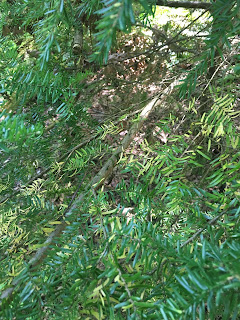It is Tuesday, May 9 at 11:50 am at my observation spot. It is clear and 64 degrees Fahrenheit outside and sunny. It feels more moist and cold in the shaded forest.
The forest is definitely quieter than my visit last week. I haven't seen any squirrels or birds except crows, of which I saw five, and there are significantly less bird calls I can hear. I am assuming this is because many of these birds may have found a mate by now. This visit, I can easily tell what trees are surrounding me because they all have finally grown new leaves. The area I'm observing from is predominantly Western Hemlock and Bigleaf Maple, with some Douglas-fir and Western Redcedar interspersed.
 |
| Western Hemlock buds |
 |
| Western Hemlock buds |
 |
| Interesting growth of Western Hemlock's branch |
 |
| Above 3 pictures- dead/dying W. Hemlock needles; in too shaded area? |
 |
| Douglas-fir baby needles :) |
There seem to be about the same amount of fallen leaves on the ground this week, but I have seen Bigleaf Maple and Douglas-fir tree leaves having grown much more heavily than my last visit. There is also an unknown plant to my left. It is about three to four feet tall, has palmately and smoothly lobed leaves, has reddish stems of leaves and green bark further down. There are more lichens on the Western Hemlock I am sitting at the base of. I couldn't identify either of them. Two are about 5 cm in diameter and are shell like growths with a whitish gray surface.
The other lichen is smaller, about 2 cm across, with four spots and a blackish coloring.
I also saw a couple of small (1 inch tall, 1 inch across) mushrooms that I cannot identify.
There are a lot less fallen flower satchels from the Bigleaf Maples this time too. Something interesting I noticed is that I saw far more flower satchels in my area than helicopter pods, which I guess makes sense since wind dispersement would carry the pods away. I have seen no animals this time sitting at my observation spot, so I can't tell if there have been any new species arriving. There are a lot more small flowers. I saw Creeping Buttercup, Herb Robert, and some bell like lavender flowers that I couldn't identify (possibly Figwort family), all growing low to the ground. Many more flowers have grown since my last visit.
 |
| Herb Robert and ? |
 |
| Creeping Buttercup |
Right now I can hear some very high pitched trills of birds responding to each other. There is also another bird with a lower but still high pitched trill.
The first invertebrate I found is a tiny light brown spider. It has a brown abdomen with darker brown dots going vertically. Its head (upper body) is a grayer brown. It has tiny light brown legs with two very long front legs that it seems to feel its way forward with. When I picked up the stick he was on, he pulled his legs in closer and formed a ball. I found it in a pile of leaves and sticks about three feet from a stream. I felt the strong urge to call this little dude a he.
 |
| Center at the top of the log- he's tiny! |
 |
| Sorry for my handwriting- "dark brown dots", "forward reaching legs. thought to be antennae at first" |
The second invertebrate I found is a millipede. It is about an inch in length, and is a medium slightly red-brown. It obviously moves and feels its way about with its two antennae. Its body moves in ripples as moving forward passed down its body. I found it in a pile of dead leaves and sticks about 10 feet from a creek. It moves quite slowly, but when it was first exposed by the movement of the leaves it started moving a lot faster. It has a sort of plated back with four legs extending in pairs from each scale on either side (8 legs per scale). The millipede has 16 scales on its entire body, so I think it has 128 total legs (16 X 8 = 128). The antennae are about twice the length of the legs.
 |
| "antenna", "scales", "4 legs/scale", "pointed end", "head looks like another scale", "4 legs/ side of scale, pair on each end" |
The third invertebrate I saw was a small snail. Its shell was shiny, and banded with dark brown and amber coloring. The snail stayed hidden inside its shell for the entirety of my observation, although I could see the body of it, so I knew it wasn't an empty shell. I found it at the base of a tree amongst some dead leaves and moist soil about 8 feet from a creek. It had a very strong smell, somewhat like a skunk.
The fourth invertebrate I found looks like a pill bug. I found it at the base of the same tree I found the snail at. It is about a centimeter long, and was on a piece of bark under some dead leaves and needles about eight feet from a creek. Its behavior was very strange, because it
barely moved. When I lightly touched it with my pencil, it moved just a tiny bit, mostly its antennae. It has kind of hidden legs under its body, but I think it has about 40 total. Its back is a mottled yellowish brown and dark brown. It literally only moved when I touched it and for little bit following my touching it. Strange critter.
 |
"antennae", "hidden legs", "scaled back", "mottled coloring"
|





























No comments:
Post a Comment